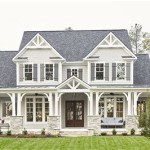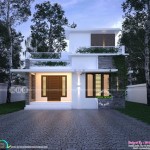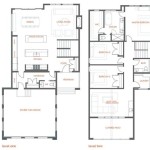Small House Plans 3 Bedroom With Dimensions
The increasing cost of land and construction materials has led to a surge in the popularity of small house plans. Many homeowners seek to maximize space and minimize expenses without sacrificing functionality or comfort. Three-bedroom small house plans present a viable solution for families or individuals who desire a balance between affordability, living space, and privacy. These plans often emphasize efficient use of space and clever design solutions to accommodate essential living areas within a smaller footprint.
Understanding the dimensions of a small house plan is paramount before commencing any building project. Accurate measurements ensure that the design fits the available land and adheres to local building codes and zoning regulations. Moreover, understanding the dimensions allows potential homeowners to visualize the layout and assess whether it meets their specific needs and lifestyle. This article will delve into the key aspects of small house plans with three bedrooms, focusing on dimensions, design considerations, and strategies for optimizing space.
Key Considerations for Small House Plans
Designing a small house plan, particularly one with three bedrooms, necessitates careful consideration of several factors. The primary goal is to create a comfortable and functional living space within a limited area. This involves strategic planning of room sizes, layouts, and the integration of multi-functional spaces. The success of a small house plan hinges on a well-thought-out design that balances aesthetics, practicality, and cost-effectiveness.
One of the initial steps is to define the overall dimensions of the house. A typical small house plan with three bedrooms might range from 800 to 1200 square feet. This figure can fluctuate based on the design complexity, the presence of additional features like garages or porches, and the specific dimensions of each room. It is important to remember that smaller dimensions do not necessarily equate to a less comfortable living experience. With careful planning and efficient design, even a small house can feel spacious and inviting.
Another critical aspect is determining the location of each room. A common layout places the bedrooms on one side of the house, providing a dedicated sleeping area. The living area, including the living room, kitchen, and dining space, is often situated on the other side. Open-concept designs are frequently employed to maximize the perception of space in the living area, allowing for a seamless flow between different zones. Consideration should also be given to the placement of bathrooms and utility areas, ensuring they are conveniently accessible without disrupting the overall flow of the house.
Efficient storage solutions are indispensable in small house plans. Built-in cabinets, shelving units, and under-stair storage can significantly reduce clutter and optimize space utilization. Vertical space should also be exploited, with tall cabinets and shelves providing ample storage without encroaching on floor space. Multi-functional furniture, such as sofa beds and tables with hidden storage compartments, can further enhance space efficiency.
Typical Dimensions and Layout Examples
To illustrate the concept of small house plans with three bedrooms and dimensions, several layout examples can be examined. These examples provide a tangible understanding of how different design choices impact the overall size and functionality of the house. The following suggestions are based on generally accepted standards, however, it is crucial to consult with a qualified architect or builder to ensure that the design adheres to local building regulations and meets your specific needs.
Example 1: Rectangular Plan (850 sq ft)
This plan features a rectangular shape, which is often the most cost-effective design to build. The overall dimensions might be around 30 feet wide and 28 feet deep.
* Bedrooms: Three bedrooms, each approximately 9 feet by 10 feet, totaling 90 square feet per room. * Living Room: An open-concept living room and kitchen area, measuring approximately 15 feet by 18 feet, totaling 270 square feet. * Kitchen: A compact kitchen layout of approximately 8 feet by 8 feet, totaling 64 square feet. * Bathroom: A single bathroom, approximately 5 feet by 8 feet, totaling 40 square feet. * Hallway and Circulation: The remaining space is allocated to hallways and circulation, ensuring easy movement between rooms.
Example 2: Square Plan (950 sq ft)
A square plan offers a balanced distribution of space and can be more energy-efficient due to its compact form. The overall dimensions might be around 31 feet by 31 feet.
* Bedrooms: Three bedrooms, two at approximately 10 feet by 10 feet (100 sq ft), and one slightly smaller at 8 feet by 10 feet (80 sq ft). * Living Room/Dining: An open-plan space approximately 16 feet by 16 feet, totaling 256 square feet, serving as both living and dining areas. * Kitchen: Located off the living area, around 8 feet by 10 feet, totaling 80 square feet. * Bathroom: A shared bathroom of approximately 6 feet by 8 feet, totaling 48 square feet. * Entryway/Hallway: A small entryway and hallway to connect the spaces.
Example 3: L-Shaped Plan (1100 sq ft)
An L-shaped plan can create distinct zones and offer greater flexibility in terms of orientation on the lot. The dimensions of the L might be approximately 40 feet by 30 feet on one arm and 20 feet by 25 feet on the other.
* Bedrooms: A master bedroom at approximately 12 feet by 12 feet (144 sq ft), and two smaller bedrooms at 10 feet by 11 feet (110 sq ft each). * Living Room: A spacious living room of approximately 16 feet by 18 feet, totaling 288 square feet. * Kitchen/Dining: A combined kitchen and dining area of approximately 12 feet by 14 feet, totaling 168 square feet. * Bathrooms: Two bathrooms, one master bath at 5 feet by 8 feet (40 sq ft) and a shared bathroom at 6 feet by 8 feet (48 sq ft). * Hallway/Utility: A dedicated hallway area and a small utility room for laundry and storage.
These examples highlight the variance in layouts and dimensions possible within a small house plan with three bedrooms. It is important to note that these dimensions are approximate and can be adjusted to suit individual needs and preferences. The key is to carefully consider the layout and dimensions of each room to ensure optimal functionality and comfort.
Strategies for Optimizing Space in Small House Plans
Maximizing space in small house plans requires a thoughtful approach to design and organization. Several strategies can be employed to create a sense of spaciousness and functionality despite the limited footprint. These strategies focus on visual perception, multi-functional design, and efficient use of storage space.
One effective strategy is to utilize an open-concept layout. Combining the living room, kitchen, and dining area into a single, flowing space eliminates physical barriers and creates a sense of openness. This arrangement also facilitates natural light penetration, making the space appear brighter and more spacious. However, it is important to clearly define each zone within the open space through the use of furniture arrangement, area rugs, and varying ceiling heights or lighting fixtures.
Strategic use of natural light can significantly enhance the perception of space. Large windows, skylights, and strategically placed doors can bring ample natural light into the house, making it feel brighter and more airy. Light-colored walls and ceilings can further amplify the effect of natural light, reflecting it throughout the space. Additionally, mirrors can be used to create the illusion of depth and expand the visual boundaries of a room.
Vertical space should be fully utilized to maximize storage capacity. Tall cabinets, shelving units that extend to the ceiling, and lofted storage areas can provide ample storage without encroaching on valuable floor space. In bedrooms, consider utilizing under-bed storage or built-in wardrobes to minimize clutter. In the kitchen, vertical storage solutions such as spice racks and hanging pot racks can free up counter space and keep essential items within easy reach.
Multi-functional furniture is another valuable tool for optimizing space in small house plans. Sofa beds can transform a living room into a guest bedroom, while tables with hidden storage compartments can serve as both a coffee table and a storage unit. Folding chairs and tables can be easily stored away when not in use, freeing up space for other activities. Choosing furniture with a smaller footprint or incorporating built-in storage can further enhance space efficiency.
Careful planning and attention to detail are essential in designing a small house plan with three bedrooms. By considering the dimensions of each room, implementing space-saving strategies, and incorporating efficient storage solutions, it is possible to create a comfortable and functional living space that meets the needs of a modern lifestyle. It is recommended to seek guidance from experienced architects and builders to ensure that the design is not only aesthetically pleasing but also structurally sound and compliant with local building codes.

Simple 3 Room House Plan Pictures 4 Nethouseplans

Small Home Plan With 3 Bedrooms Cool House Concepts

Small 3 Bedroom House Plan With Pictures 55sqm Plandeluxe

Small Home Design Plan 6 5mx12m With 3 Bedrooms

3 Bedroom Small House Plans For Narrow Lots Nethouseplans

Stylish Low Budget Modern 3 Bedroom House Design Plans Blog Floorplans Com

3 Bedroom House Plans Home Designs Nethouseplans

3 Bedroom Contemporary Home Design Pinoy House Designs

Small House Design With 3 Bedrooms
3 Bedroom House Plans Three Design Bhk Plan Civiconcepts








